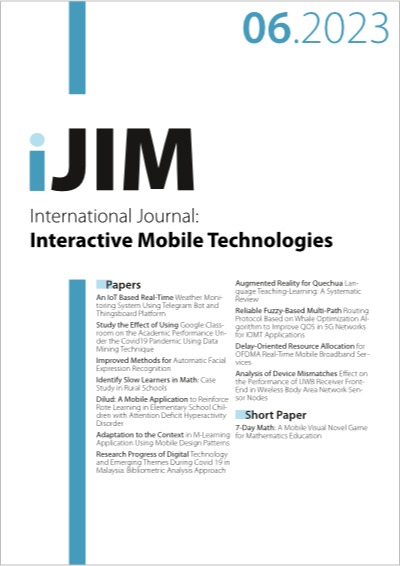Reliable Fuzzy-Based Multi-Path Routing Protocol Based on Whale Optimization Algorithm to Improve QOS in 5G Networks for IOMT Applications
DOI:
https://doi.org/10.3991/ijim.v17i06.38801Keywords:
Internet of Medical Things (IoMT), 5G, Quality of Services (QoS), Reliable Fuzzy based Multi-path routing protocol (RFMRP), Whale Optimization Algorithm (WOA), residual energy based Cluster Head (CH) selection algorithmAbstract
The Internet of Medical Things (IoMT) faces stiff competition from the 5th Generation (5G) communication standard, which includes attributes like short and long transmission ranges, Device to Device (D2D) connectivity, low latency, and high node density. To function in the linked ecosystem, IoMT based on 5G is anticipated to have a diversity of energy and mobility. It is currently difficult to create an IoMT routing system based on 5G that maximizes energy efficiency, lowers transmission latency, and increases network lifespan. The "Quality of Services (QoS)" in 5G-based IoMT is improved by the Reliable Fuzzy-based Multi-path routing system shown in this study. The Whale Optimization Algorithm (WOA) enhances the routing protocol performance. The residual energy-based Cluster Head (CH) selection strategy rotates the CH location among nodes with greater energy levels than the others. The method chooses the following set of CHs for the network that is suitable for IoMT applications by considering initial energy, residual energy, and an ideal value of CHs. According to the simulation results, our suggested routing technique enhances QoS in comparison to current approaches.
Downloads
Published
How to Cite
Issue
Section
License
Copyright (c) 2023 Haider TH.Salim ALRikabi, Farah Saad Al-Mukhtar, Zahraa A. Jaaz, Aws H. Hamad

This work is licensed under a Creative Commons Attribution 4.0 International License.



